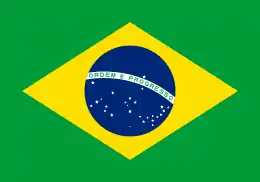Brazilian diaspora
The Brazilian diaspora refers to the migration of Brazilians to other countries, a mostly recent phenomenon that has been driven mainly by economic recession and hyperinflation that afflicted Brazil in the 1980s and early 1990s, and since 2014, by the political and economic crisis that culminated in the impeachment of Dilma Rousseff in 2016 and the election of Jair Bolsonaro in 2018, in addition to chronic urban violence in Brazilian urban centers.[19][20][21]
Demographics

There are an estimated 4,2 million Brazilians living abroad,[22] mainly in the U.S. (1,775,000),[23] Japan (206,365),[24] Paraguay (240,000), Portugal (276,000), Spain (156,000), Germany (144,000) and United Kingdom (220,000).
United States
There were an estimated 246,000 Brazilian Americans as of 2007.[25] Another source gives an estimate of some 800,000 Brazilians living in the U.S. in 2000,[26] while still another estimates that as of 2008 some 1,100,000 Brazilians live in the United States, 300,000 of them in Florida.[27] Major concentrations are in Massachusetts, New York, New Jersey, Connecticut, Pennsylvania, Georgia, Florida, Wisconsin, and California.
West 46th Street has historically been a commercial center for Brazilians living or visiting New York City. In 1995 the city officially recognized it as "Little Brazil Street".
In Massachusetts, there is a very small but significant concentration of Brazilian immigrants in the town of Framingham, which in recent years has spilt out into the neighboring towns of Marlborough and Hudson, among others. In the Brazilian community, it is said that Pompano Beach in Florida has the greatest concentration of Brazilians in the USA. The Brazilian communities in these towns are vibrant, having contributed much to the local cuisine and culture, but Brazilian immigrants often feel discriminated against and are often thought to be illegal immigrants by their non-Brazilian neighbors.[28]
A disproportionate number of Brazilians who have emigrated to the US came from the town of Governador Valadares, in the state of Minas Gerais.
United Kingdom
There are no precise figures for the number of Brazilians living in the UK.[29] The 1991 Census recorded 9,301 Brazilian-born people in the UK,[29] and the 2001 Census recorded 15,215.[30] In 2004, the Brazilian Consulate in London recorded 13,000 Brazilians who had voluntarily registered themselves with them, but said this was not an accurate figure for the number living in the UK; the Brazilian Embassy estimated that figure to be about 80,000.[29] The Office for National Statistics estimates suggest that there were 56,000 Brazilian-born people resident in the UK in 2008.[31] In 2015, the Brazilian Consulate estimated a total of 120,000 Brazilians resident in the UK.[32] The ONS estimated that in 2018, 87,000 people born in Brazil were living in the UK.[33]
Japan
The majority of Brazilians living in Japan are of Japanese descent, and they have been migrating there since 1990 when the Immigration Act was altered to allow children and grandchildren of Japanese nationals, as well as their non-Japanese spouse, to receive a work permit easily. Most of them live in industrial areas where there used to be a plenty of job offers at factories, such as Aichi, Shizuoka and Gunma Prefectures, among others. While approximately 300,000 Brazilians lived there at its climax, the economic crisis in 2008 slashed their job and more than a third of them have decided to return to Brazil.
Canada
There are an estimated 22,920 Brazilians living in Canada.[34] Major concentrations are in Toronto, Montreal, Vancouver, and Calgary.
Germany
France
Portugal
Portugal is another important destination for Brazilians, owing to a common language and given the fact that a significant number of Brazilians already hold Portuguese citizenship (particularly after Portugal modified its nationality law to be able to bestow it upon any grandchild of a verified Portuguese citizen). Cultural similarities are abundant and the Portuguese are fairly acquainted with Brazilian pop culture. Approximately a fourth of all foreigners currently residing in Portugal are Brazilian citizens.
Paraguay
Brazilians and their descendants living in Paraguay are called Brasiguayos. This numerous community of landowners is mainly involved in agriculture.
Mexico
Australia
Angola
Organizations
- Brazilian Immigrant Center Boston
- Brazilian Community in Massachusetts in English
- Brazilian Community in California in English
- Brazilian Community in New Jersey in English and Portuguese
- Brazilian Community in New York in English
- BCA-Brazilian Community Association in British Columbia Vancouver
- Estimates of Brazilians living abroad by region in Portuguese
Statistics
References
- "Comunidade Brasileira no Exterior - Estimativas referentes ao ano de 2020" (PDF) (in Portuguese). Ministry of External Relations. 14 September 2020. Retrieved 24 February 2021.
- "令和3年6月末現在における在留外国人数について | 出入国在留管理庁".
- "Brasil - Emigrantes totais 2019".
- "Brazil". Ethnologue. Retrieved 21 July 2015.
- "Brasil possui 5 línguas indígenas com mais de 10 mil falantes-Fonte: Agência Brasil". ebc. 2014-12-11. Retrieved 11 April 2016.
- "Hunsrick". Ethnologue. Retrieved 20 July 2015.
- "Venetian or Talian". Ethnologue. Retrieved 21 July 2015.
- Costa, Luciane Trennephol da; Gielinski, Márcia Inês (17 August 2014). "DETALHES FONÉTICOS DO POLONÊS FALADO EM MALLET". Revista (Con)textos Linguísticos. 8 (10): 159–174 – via periodicos.ufes.br.
- Delong, Silvia Regina; Kersch, Dorotea Frank (17 September 2014). "Perfil de descendentes de poloneses residentes no sul do Brasil: a constituição da(s) identidade(s)". Domínios de Lingu@gem. 8 (3): 65–85. doi:10.14393/DLesp-v8n3a2014-5.
- "O panorama lingüístico brasileiro: a coexistência de línguas minoritárias com o português" (PDF).
- Oksana Boruszenko and Rev. Danyil Kozlinsky (1994). Ukrainians in Brazil (Chapter), in Ukraine and Ukrainians Throughout the World, edited by Ann Lencyk Pawliczko, University of Toronto Press: Toronto, pp. 443–454
- "E o terceiro fluxo, entre 1949 e 1965, quando chegaram ao Brasil aproximadamente 25 mil russos refugiados da revolução cultural chinesa". noticias.terra.com.br. 2015-06-13. Retrieved 2016-05-05.
- "Vlax Romani in Brazil". Ethnologue. Retrieved 21 July 2015.
- Freyre, Gilberto (2000). Ingleses no Brasil: aspectos da influência britânica sobre a vida, a paisagem e a cultura do Brasil (in Portuguese). Topbook. ISBN 9788574750231.
- "Ingleses no Brasil do século XIX". livrariacultura. Retrieved 10 April 2016.
- Harter, Eugene C. (2000). The Lost Colony of the Confederacy. Texas A & M University Press. p. 44. ISBN 978-1585441020.
- "Edwin S. James research materials". University of South Carolina. Retrieved 2014-01-05.
- "MCMULLAN, FRANCIS". Texas State Historical Association. 2010-06-15. Retrieved 2014-01-05.
- Batista, Henrique Gomes (11 June 2017). "Crise e violência levam brasileiros a se mudar para o Canadá". O Globo (in Brazilian Portuguese). Retrieved 14 December 2021.
- Perez, Fabíola (21 August 2015). "O êxodo dos brasileiros". IstoÉ (in Brazilian Portuguese). Retrieved 14 December 2021.
- Veiga, Edison (13 December 2021). "Brasil vive o maior êxodo de sua história". Deutsche Welle (in Brazilian Portuguese). Retrieved 14 December 2021.
- "Brasileiros no estrangeiro" (PDF).
- U.S. Census Bureau, American FactFinder Archived 2020-02-12 at archive.today
- "令和3年6月末現在における在留外国人数について | 出入国在留管理庁".
- "United States - Selected Population Profile in the United States (Brazilian (360-364))". 2007 American Community Survey. United States Census Bureau. Archived from the original on 2020-02-12. Retrieved 2008-12-15.
- "Brazilian Immigrant Women in the Boston area: Negotiation of Gender, Race, Ethnicity, Class and Nation". Archived from the original on 28 January 2010.
- "Imigrante brasileiro espera anistia de sucessor de Bush - 01/11/2008 - UOL Eleição americana 2008". Noticias.uol.com.br. Retrieved 2012-08-13.
- The Massachusetts Legal Services Diversity Coalition (2004). "Brazilian Immigration". Archived from the original on 29 September 2007. Retrieved 7 November 2012.
- Burton, Guy (July 2004). "It's tough being Brazilian in the UK". Brazzil. Retrieved 5 April 2010.
- "Country-of-birth database". Organisation for Economic Co-operation and Development. Archived from the original on 17 June 2009. Retrieved 5 April 2010.
- "Table 1.3: Estimated population resident in the United Kingdom, by foreign country of birth, 60 most common countries of birth, January 2008 to December 2008". Office for National Statistics. Archived from the original on 5 June 2011. Retrieved 5 April 2010. Figure given is central estimate. See the source for 95 per cent confidence intervals.
- "Brasileiros no Mundo - Estimativas" [Brazilians Around The World - Estimations] (PDF) (in Portuguese). Ministry of External Relations. 2015-03-28. Archived from the original (PDF) on 2020-07-31. Retrieved 2016-03-24.
- "Table 1.3: Overseas-born population in the United Kingdom, excluding some residents in communal establishments, by sex, by country of birth, January 2018 to December 2018". Office for National Statistics. 24 May 2019. Retrieved 15 August 2019. Figure given is the central estimate. See the source for 95% confidence intervals.
- "Canada's 2011 National Household Survey: Data tables". Statistics Canada. 8 May 2013. Retrieved 1 January 2015.
- "Estimativas RCN 2015" (PDF). Archived from the original (PDF) on 2020-07-31. Retrieved 2019-08-10.
External links
- Brazilian Times (Brazilian newspaper in the U.S.)
- The Brasilians (Brazilian newspaper in New York)
- "Japan's fear of Brazilians", BBC News
- Brazilians in London, BBC London
- Brazilian Educational and Cultural Centre (BrEACC)
